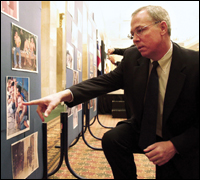A
CLOSE-UP OF MS-13
FBI Executive Visits El Salvador
04/19/06
 |
|
FBI
exec James "Chip" Burrus
observes photos of detained gang members
at the second annual Gang Enforcement
Conference in San Salvador. AP Photo
|
The
FBI’s Criminal Investigative Division
chief recently did some intelligence gathering
of his own on MS-13, a violent gang that
is sowing fear and crime in communities
in 33 states. James “Chip” Burrus
spent three days in El Salvador to learn
how officials there are battling the scourge
before it becomes a bigger problem here.
Burrus
was among about 100 FBI and U.S. law enforcement
officials attending the second annual Gang
Enforcement Conference in San Salvador
in early April. The event, viewed as invaluable
for its insights into the ways of MS-13,
or Mara Salvatrucha, was attended by top
officials from Guatemala, Mexico, Panama,
Nicargua, Honduras, and El Salvador, where
the gang originated in the late 80s. During
the three-day conference, each country
spoke at length about how they wage battle
against MS-13 cliques, as they are called,
which carve poor neighborhoods into territories
and trade heavily in extortion and murder.
“What
it did for me is it gave me an insight
of what the gang looks like not only in
El Salvador and Central American countries,
but what it perhaps looks like here,” Burrus
said. “How do they make money down
there? What is their structure? It helps
me be a little more predictive in placing
resources.”
The
FBI has been placing more and more resources
on the front lines of the MS-13 problem.
There are an estimated 10,000 MS-13 gang
members in the U.S. and five times as many
in the countries that attended the conference.
In 2004, the FBI created the MS-13 National
Gang Task Force. In 2005, the FBI helped
create a National Gang Information Center
and outlined a National Gang Strategy for
Congress.
Last
year, the MS-13 task force coordinated
a series of arrests and crackdowns in the
U.S and Central America that involved more
than 6,000 police officers in five countries.
Seventy-three suspects were arrested in
the U.S.; in all, more than 650 were taken
into custody.
Burrus’ visit
took him beyond the conference meeting
rooms where officials traded tactics and
methods on panels and in break-out groups.
In an armored van with a lead escort and
Salvadoran sharp-shooters at the ready,
Burrus rode deep into a neighborhood where
the “maras,” or gang members,
hold sway.
“It
was an eye-opening experience to see what
it could come to at some point here if
we don’t do our jobs correctly,” Burrus
said. “It’s a much bigger problem
for them because it’s rooted there.
What were trying to prevent is for them
to get historically rooted here in the
U.S.”
Burrus’ tour
also took him to El Salvador’s intelligence
center—where a few resourceful police
enter reports, interviews, and intelligence
into a handful of old computers that comprise
a surprisingly effective database.
Burrus
is exploring ways to bolster the law enforcement
link with El Salvador—with training
or technology. Fingerprinting MS-13 members
in Salvadoran prisons—and linking
those prints to the FBI database—could
go a long way to stopping them before they
enter the U.S, Burrus said.
“There’s
such freedom of movement between El Salvador
and the United States. So there’s
a real need for an exchange of information
between the two countries—what’s
working and what’s not.”
Resources: Violent
Gangs webpage | How
We’re Targeting MS-13 | 2005
National Gang Threat Assessment


